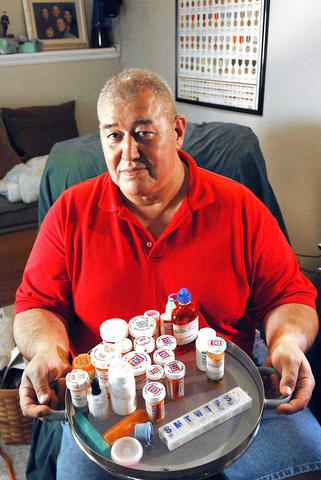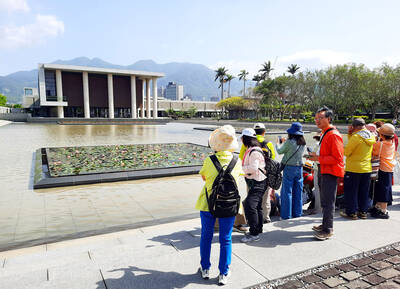People in the US are living in a world of pain and they are popping pills at an alarming rate to cope with it.
The amount of five major prescription painkillers sold at retail establishments rose 88 percent between 1997 and 2005, according to an Associated Press analysis of statistics from the Drug Enforcement Administration.
More than 90,720kg of codeine, morphine, oxycodone, hydrocodone and meperidine were purchased at retail stores during the most recent year represented in the data. That total is enough to give more than 300mg of painkillers to every person in America.

PHOTO: AP
Oxycodone, the chemical used in OxyContin, is responsible for most of the increase. Oxycodone use jumped nearly six-fold between 1997 and 2005. The drug gained notoriety as "hillbilly heroin,'' often bought and sold illegally in Appalachia.
An AP investigation found these reasons for the increase:
* The population is getting older. As age increases, so does the need for pain medications. In 2000, there were 35 million people older than 65. By 2020, the Census Bureau estimates the number of elderly in the US will reach 54 million.
* Drug makers have embarked on unprecedented marketing campaigns.
* Spending on drug marketing has gone from US$11 billion in 1997 to nearly US$30 billion in 2005, congressional investigators found. Profit margins among the leading companies routinely have been three and four times higher than in other Fortune 500 industries.
* A major change in pain management philosophy is now in its third decade. Doctors who once advised patients that pain is part of the healing process began reversing course in the early 1980s; most now see pain management as an important ingredient in overcoming illness.
Retired Staff Sergeant James Fernandez, 54, of Fredericksburg, Virginia, survived two helicopter crashes and Gulf War Syndrome over 20 years in the Marine Corps. He remains disabled from his service-related injuries and takes the equivalent of nine painkillers containing oxycodone every day.
"It's made a difference,'' he said. "I still have bad days, but it's under control.''
Such stories should hearten longtime advocates of wider painkiller use, such as Russell Portenoy, head of New York's Beth Israel pain management department. But they have not.
"I'm concerned and many people are concerned,'' he said, "that the pendulum is swinging too far back.''
Consider: More people are abusing prescription painkillers because the medications are more available. The vast majority of people with prescriptions use the drugs safely. But the number of emergency room visits from painkiller abuse has increased more than 160 percent since 1995, according to the government.
Perhaps no place illustrates the trends and consequences for the world of pain better than Myrtle Beach, South Carolina, a sprawling community of strip malls, hotels and bars perched along a 100km strip of sand on the Atlantic Ocean. The metro area, which includes three counties, is home to 350,000 people but sees more than 14 million tourists annually, drawn to its warm water, golf courses and shopping.
During the eight-year period reflected in government figures, oxycodone distribution increased 800 percent in the area of Myrtle Beach, partly due to a campaign by Purdue Pharmaceuticals. The privately held company has pleaded guilty to lying to patients, physicians and federal regulators about the addictive nature of their drug.
Use of other drugs soared in the area, too: Hydrocodone use increased 217 percent; morphine distribution went up 180 percent; even meperidine, most commonly sold as Demerol, jumped 20 percent.
It is no small wonder that federal authorities suspected the area was home to a notorious "pill mill,'' or a clinic that dispenses prescription medication without verifying that it is needed.
The US attorney for South Carolina secured a 58-count indictment in June 2002 against seven physicians and one employee of the Comprehensive Care and Pain Management Center, a nondescript storefront on Myrtle Beach's main drag.
Tipped off by local pharmacists concerned about an increase in the volume of painkiller prescriptions, the federal investigation created a furor in the medical profession. The owner, Michael Woodward, was sentenced to 15 years in the case and has relinquished his license.
A second physician, Deborah Bordeaux, had worked at the clinic less than two months before quitting in disgust. Bordeaux, now serving a two-year prison term, was threatened with a 100-year sentence if she did not help the prosecution.
Officials with the Justice Department and the DEA would not discuss what some activists say is a "war on doctors.''
The DEA cites 108 prosecutions of physicians during the past four years; 83 pleaded guilty or no contest, while 16 others were convicted by juries. Eight cases are pending, and one physician is being sought as a fugitive.
In congressional testimony, the agency's deputy assistant administrator, Joseph Rannazzisi, estimated that fewer than 1 percent of the nation's physicians - under 9,000 - illegally provide prescription drugs to patients. He told lawmakers it is far more common for people to illegally obtain prescription drugs from friends and family members.
"It is not merely illegal but could feed or lead to an addiction and place that loved one in a life-threatening situation,'' Rannazzisi said.
It is impossible to reliably measure painkiller abuse.
A 2004 government study estimated between 2 million and 3 million doses of codeine, hydrocodone and oxycodone are stolen annually from pharmacies, distributors and drug manufacturers.

When the South Vietnamese capital of Saigon fell to the North Vietnamese forces 50 years ago this week, it prompted a mass exodus of some 2 million people — hundreds of thousands fleeing perilously on small boats across open water to escape the communist regime. Many ultimately settled in Southern California’s Orange County in an area now known as “Little Saigon,” not far from Marine Corps Base Camp Pendleton, where the first refugees were airlifted upon reaching the US. The diaspora now also has significant populations in Virginia, Texas and Washington state, as well as in countries including France and Australia.

On April 17, Chinese Nationalist Party (KMT) Chairman Eric Chu (朱立倫) launched a bold campaign to revive and revitalize the KMT base by calling for an impromptu rally at the Taipei prosecutor’s offices to protest recent arrests of KMT recall campaigners over allegations of forgery and fraud involving signatures of dead voters. The protest had no time to apply for permits and was illegal, but that played into the sense of opposition grievance at alleged weaponization of the judiciary by the Democratic Progressive Party (DPP) to “annihilate” the opposition parties. Blamed for faltering recall campaigns and faced with a KMT chair

Article 2 of the Additional Articles of the Constitution of the Republic of China (中華民國憲法增修條文) stipulates that upon a vote of no confidence in the premier, the president can dissolve the legislature within 10 days. If the legislature is dissolved, a new legislative election must be held within 60 days, and the legislators’ terms will then be reckoned from that election. Two weeks ago Taipei Mayor Chiang Wan-an (蔣萬安) of the Chinese Nationalist Party (KMT) proposed that the legislature hold a vote of no confidence in the premier and dare the president to dissolve the legislature. The legislature is currently controlled

Dull functional structures dominate Taiwan’s cityscapes. But that’s slowly changing, thanks to talented architects and patrons with deep pockets. Since the start of the 21st century, the country has gained several alluring landmark buildings, including the two described below. NUNG CHAN MONASTERY Dharma Drum Mountain (法鼓山, DDM) is one of Taiwan’s most prominent religious organizations. Under the leadership of Buddhist Master Sheng Yen (聖嚴), who died in 2009, it developed into an international Buddhist foundation active in the spiritual, cultural and educational spheres. Since 2005, DDM’s principal base has been its sprawling hillside complex in New Taipei City’s Jinshan District (金山). But